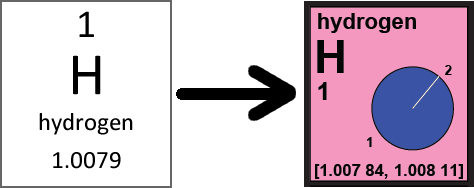Atomic Weight Intervals and the IUPAC Periodic Table of the Elements and Isotopes
Concept Question: How should I interpret the new Periodic Table of the Elements and Isotopes?
Consult the periodic table in your textbook or on your classroom wall. If it lists a single number for the atomic weight of all elements, this no longer reflects what scientists have learned about how atomic weights change for some elements based on the nature of the sample. Mass spectrometry technology is now sensitive enough to detect that there are slight variations in isotopic abundances for some elements, depending on where a sample is taken from. Since different samples of these elements have slightly different isotopic abundances, their atomic weights will be different - for these elements, their atomic weights are not constants of nature. While this complicates calculations, scientists can exploit these differences to distinguish between samples, leading to many important applications.
The atomic weights for some elements (shown in pink on the IUPAC Periodic Table of the Elements and Isotopes) are now listed as an interval atomic weight. There is no one exact number for all samples because relative abundances of different samples have minute variations. The upper and lower limits for these intervals are listed inside of square brackets. Open the IUPAC Periodic Table of the Elements and Isotopes Learning Tool and find the elements which now have an interval atomic weight.
